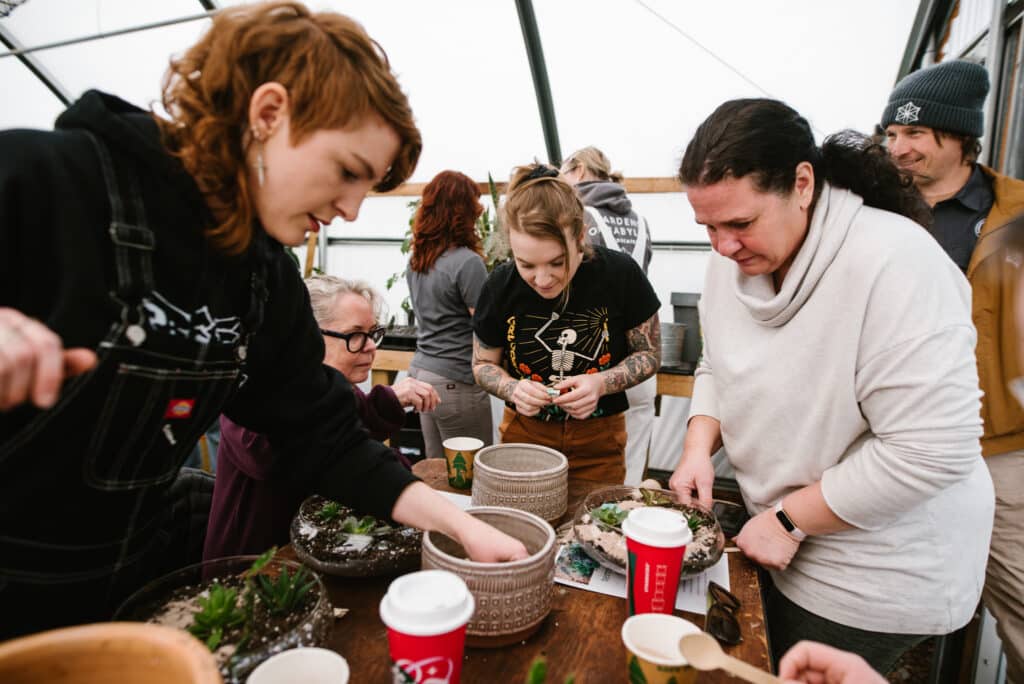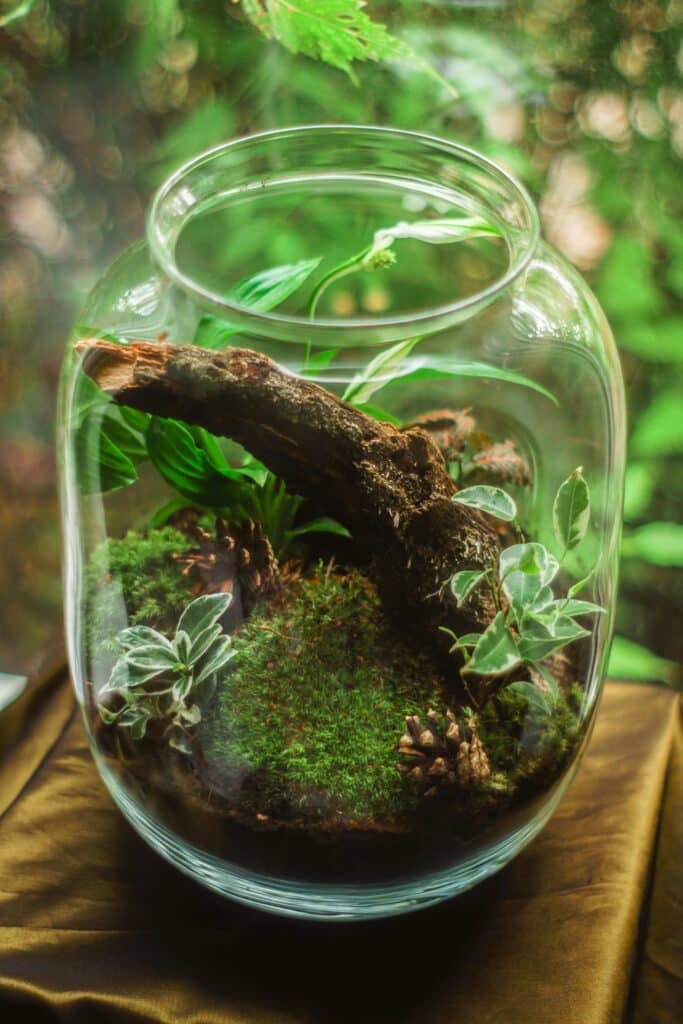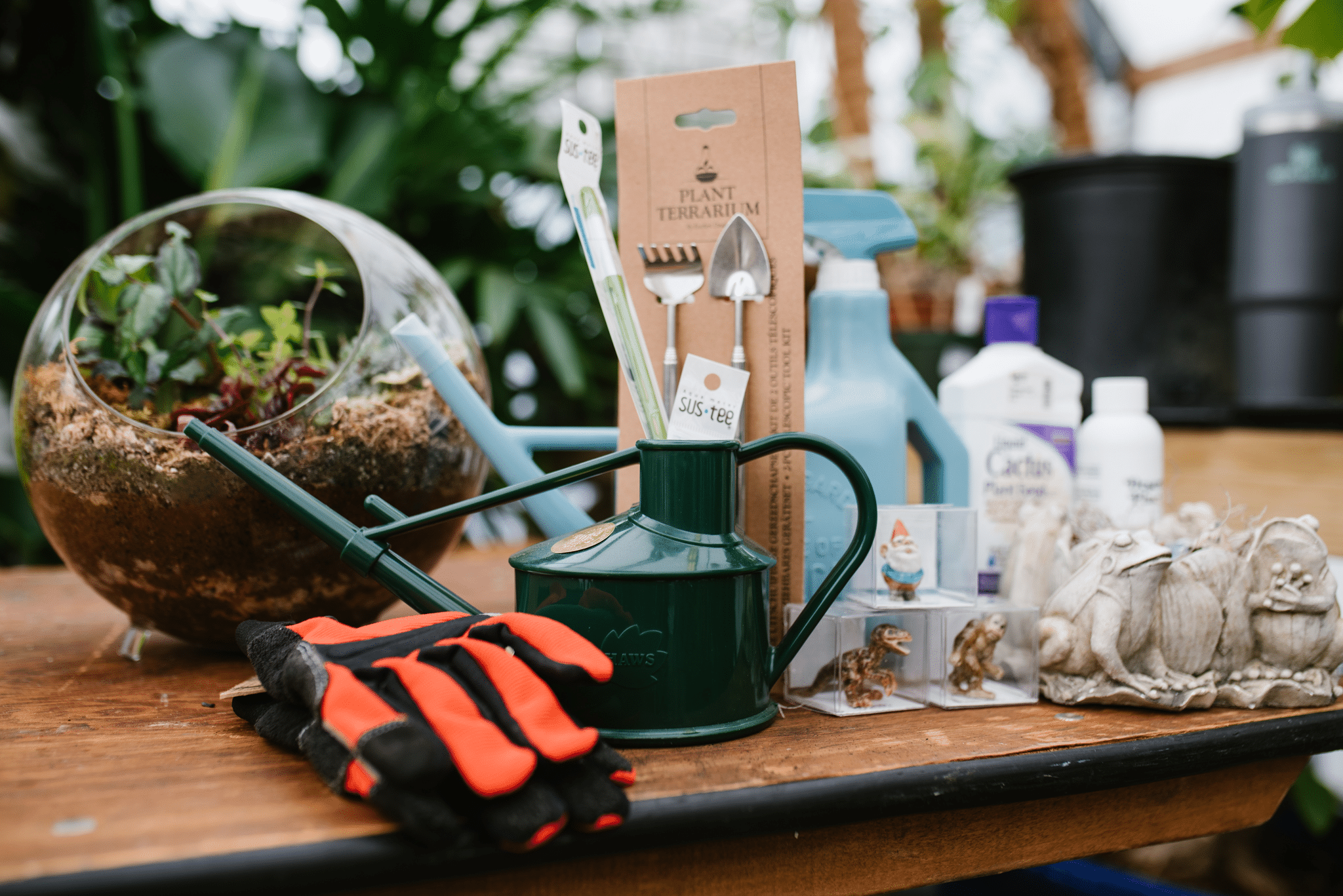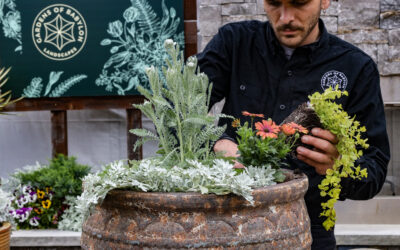If you want to have a hands-on terrarium-building experience, check out our upcoming Terrarium Building Workshop!
We love terrariums because it feels like you’re creating your own mini world that you can then maintain and nurture for years to come! Not only are they aesthetically pleasing statement pieces that can be used as home decoration, but they’re also like living art that when maintained correctly can live for years – and even decades in the right containers! If you’re testing out your green thumb, but don’t have the space to add large indoor plants, then a lush, beautiful terrarium can be the perfect alternative to add some greenery into your space. It’s ideal for small space dwellers, beginners, and busy plant parents since they don’t take up too much space, and they’re easy to maintain. It’s also a great hobby and chic décor for your home.

Gardens of Babylon Terrarium Supplies
Benefits of terrariums
Terrariums bring a multitude of benefits into your home, creating a harmonious blend of nature and design. Not only do they offer a haven for plants that thrive in a more humid environment, solving the challenge of growing them in dry air, but they also provide a charming confined space for a mini garden to flourish. The efficiency of artificial light, whether it be the warm glow of LEDs or the crisp illumination of fluorescents, can be harnessed to perfection within the glass confines. Plus, the low-maintenance nature of terrariums means you won’t find yourself constantly reaching for the watering can. Beyond the practical advantages, there’s an undeniable joy in curating and caring for your very own mini living ecosystem – a delightful and fulfilling experience that brings the outdoors inside, creating a serene connection between nature and your living space.

Gardens of Babylon Terrarium Building
Types of terrariums
There are two types of terrariums, sealed and open. Sealed terrariums have a removable lid, which is ideal for tropical foliage like ferns, calathea, nerve plants, carnivorous plants, etc. Open terrariums allow air to circulate in the container, which is ideal for plants that need ventilation to thrive (i.e. succulents, cacti, airplants, etc.). Some folks introduce beneficial insects or fauna into their terrariums to create a vivarium – a symbiotic relationship that allows all of the living elements of the ecosystem to help each other live and grow.

Getting started
Before immersing yourself in the realm of terrarium building, take a moment to explore different styles and designs that speak to your unique aesthetic. Be intentional in choosing the type of terrarium, container, and plants that will bring your vision to life – we suggest selecting 2-3 plants to keep things harmonious. With your design in mind, gather all your supplies ahead of time, ensuring a serene and stress-free environment. Now, let’s venture into the step-by-step journey below, transforming your creative vision into a tangible masterpiece that effortlessly blends nature with your distinctive style.
- Start with a layer of drainage rocks, approx. ½ an inch to 2 inches deep, depending on the size of the vessel. This layer acts as a reservoir where the overflow water collects.
- Add a thin layer of activated horticultural charcoal, about ½ an inch, to filter water, break down harmful bacteria, and absorb plant pathogens or toxins.
- Then add your layer of potting soil. Depending on the type of terrarium you’re creating, you’ll either choose a tropical houseplant mix, or a cactus mix. Each soil type is specially formulated to provide optimum aeration and drainage, along with microbes that promote root growth for healthier plants.
- Next, you can play around with the arrangement of your plants within your vessel. Remember, there is no rule in creating and placing plants in your terrarium! You can create a landscape with pebble walkways, a whimsical nook for a fairy or gnome to relax, or a calming desert oasis that reminds you of your favorite vacation spot!
- Finally, now it’s time to add your plants! Start with the largest plant first, and work your way to the smallest. You can use gloves to protect your hands from the prickly plants. Make sure to unravel the roots gently before you nestle them into the soil so that they can find their way through the container and don’t continue to wrap themselves around the plant.
- Once you’re happy with your plant placement, it’s time to accessorize! Add in decorative elements like preserved moss, gemstones, figurines, driftwood, top rocks or desert sand to make it personalized and unique to your aesthetic!

Care
Terrariums, with their captivating greenery enclosed in glass, bring a touch of nature into our homes, and while they’re generally low maintenance, a few thoughtful steps can ensure their longevity and vibrancy. Picture it as cultivating a small piece of the outdoors within the sanctuary of your living space. So, let’s dive into some suggestions to nurture your terrarium and keep it flourishing
- Watering needs:
- For open desert terrariums, the easiest way to assess for watering needs is to feel the leaves or foliage of the succulents and cacti. If the leaves feel limp, wilted, wrinkly or look pale in color, the plant needs a thorough drink of water. Once the leaves are plump, firm, and look vibrant in color again, this is an indication that the plant is well watered. For closed tropical terrariums, feel the soil, and make note of any condensation on the glass. The leaves may droop if they’re thirsty.
- A well-watered closed terrarium will have condensation on the inside of the glass and the soil will have a light sheen of moisture on the top. If you’re not seeing any condensation at all, or if you see any dead leaves or dry soil, you may need to add a little bit of moisture into the environment.
- Light needs:
- Most terrariums will thrive in a bright room where they can get indirect light throughout most of the day. Within 5 feet of an Eastern or Western facing window would be ideal for most terrariums, and a South facing window with a sheer curtain or dappled afternoon sun would be best for desert terrariums that can handle brighter light.
- Be cautious to not place glass terrariums in a spot that receives an abundance of direct sunlight, this can magnify the sun rays and potentially burn your plants!
- Pest control:
- If you have an open terrarium, monitor for pests such as gnats or mealy bugs. If you have a closed terrarium, you may want to remove the lid every now and then to let in some fresh air.
- Excessive moisture can cause issues like root rot or mold, and can also attract pests such as fungus gnats. If your closed terrarium has heavy water droplets and dark, consistently wet soil, it would be best to leave the container open and let it dry out a bit before sealing it again.
- Other tips:
- Rotate your containers every so often for even growth on all sides of the plant.
- Make sure to remove yellow and brown leaves from any plants in your terrarium.
- Since terrariums don’t have the capacity to break down dead organic matter in the way that a forest floor does, the dead leaves will likely sit there, rot, and potentially spread pathogens to your plants or soil, so it’s best to remove any dead matter as soon as you can.






0 Comments